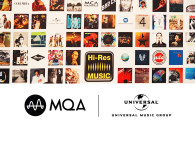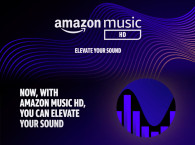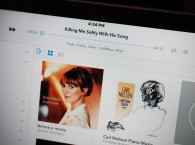The topic of high-resolution audio (HRA) is back in force - better said, High Resolution Music. This is because the Recording Industry Association of America (RIAA), in cooperation with The Digital Entertainment Group (DEG) and The Recording Academy Producers & Engineers Wing announced they would be adopting a new logo to promote the adoption of high-resolution music.

The RIAA announcement was supported by a number of high-res music retailers - including Acoustic Sounds Super HiRez, Blue Coast Music, HDtracks, IsoMike Recordings, ClassicsOnline HD*LL (operated by the Naxos Group of Companies), PonoMusic, and ProStudioMasters - which agreed to adopt the Hi-Res MUSIC logo licensing agreement and have begun integrating the logo into their websites and branding materials.
According to David Hughes, Chief Technology Officer, RIAA, "Our ultimate goal is to ensure that music enthusiasts can more easily identify their highest quality preferences, and this is a key step in that process. We thank those that have adopted the Hi-Res MUSIC logo, and encourage others in this space to follow suit, in order to help consumers enjoy the highest-quality digital recordings possible."
This new Hi-Res MUSIC logo was developed by 2B Communications at the request of Sony Music Entertainment, Universal Music Group and Warner Music Group, and was designed to help music fans identify those high resolution recordings that are available from digital music retailers in the US, Canada, and Europe for commercial downloads or streaming. High Resolution Music is officially defined as "lossless audio capable of reproducing the full spectrum of sound from recordings which have been mastered from better than CD quality (48 kHz/20-bit or higher) music sources that represent what the artists, producers and engineers originally intended."
According to the RIAA, "The definition ensures consumers receive music delivered in a digital format that retains the highest sound quality available during the creative or transferring process. The Hi-Res MUSIC logo must be accompanied by the name and resolution of the digital format, in order to provide consumers with as much information about the recording as possible."
"The logo is a critical step in clarifying what qualifies as 'Hi-Res Audio'," said Marc Sheforgen, Chief Operating Officer, Acoustic Sounds Super HiRez. "The proof is in the sound, of course, but having a visual signpost to alert someone to the opportunity for this enhanced experience should simplify consumer decision-making. There's now a means of visually shopping the highest-end digital format."
This is a positive move from the music industry and I see no reason to criticize a legitimate marketing effort. My only remark would be that we already have another logo in use. This announcement clearly says the new logo is to be used by "digital music retailers and record labels." So, this is different from the original High-Resolution Audio logo announced back in June 2014, by The Digital Entertainment Group (DEG), in cooperation with the Consumer Electronics Association (CEA) and The Recording Academy, also in partnership with Sony Music, Universal Music and Warner Music. We now have the HRA logo to be used just for the hardware and the Hi-Res Music logo for the software? It doesn't seem to be the best strategy.

From the "hardware" side, according to the Consumer Technology Association (former CEA), more than half of recent audio technology consumers are interested in HRA and three-quarters researched audio products in physical stores. This is according to a recent new study from the CTA, "Consumers Journey to Purchase: Audio."
According to the study, interest in HRA is notably strong, with more than half (53%) of consumers who purchased an audio product online or in-store in the past year interested in HRA. "Music enthusiasts and audiophiles - two subgroups of audio consumers looking for a "better" audio experience - are among the primary consumer targets for HRA. The study finds, however, that consumer interest in HRA can falter when equipment and software upgrades are needed. "To combat this, manufacturers should consider marketing on a personal level and offering in-store demonstrations and promotions of high-resolution products," they say.
The CTA study also says "Our study finds that 'connectivity' is a key area in which retailers can better educate their customers. Even as consumers more frequently use streaming services and apps at home (86 percent) and in-vehicle (69 percent), they struggle to conceptualize the benefits of connectivity further than sharing playlists or streaming via Bluetooth."

That is precisely why I believe the Master Quality Authenticated (MQA) new digital audio encoding technology is so important. It makes lossless HRA streaming practical, it combines high-quality encoding of the master recordings and, most importantly, it combines an encapsulated format with metadata to ensure that consumers can identify the quality of the encoded content, while, at the same time, allowing decoding of the content by non-MQA compatible systems, when not available.
In my opinion, this is the perfect embodiment of a solution that both protects and respects consumers. Because offering quality audio - as close to the master recording as possible - is mainly a consumer's right. But MQA essentially offers convenience. Convenience, much more than marketing or logos will be the most effective way of promoting higher-quality audio.
And that's why I think that along with the evolution on wireless audio streaming technologies (think - WiSA), MQA will be undoubtedly one of the most exciting topics to follow at the forthcoming CES 2016 show.







